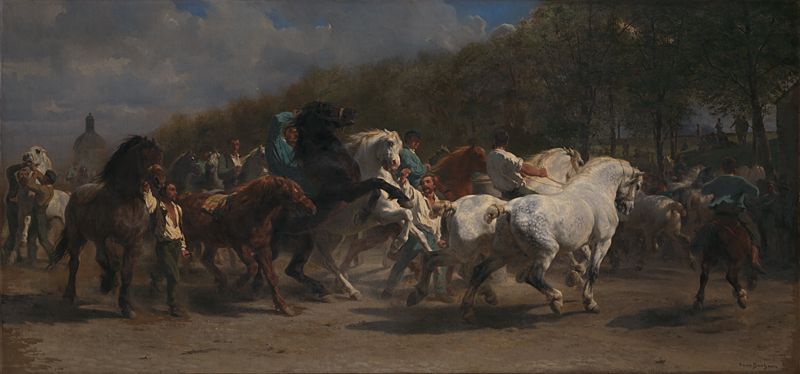ARTiSTORY celebrate artists, designers, craftspeople, and creatives from all walks of life, cultures and centuries, each day of the year. ART is for everyone.
For LGBT+ History Month, celebrated in February in the UK, and in other months throughout the year globally, for Valentine’s Day also, we share here, Rosa Bonheur.
When looking at a painting, each viewer and each generation discovers more about the subject matter, the artist and how they lived and loved. It’s only in recent years that the art and history books and conversations today discuss and acknowledge these more personal, yet important aspects about the lives of those lived before us.
Rosa Bonheur’s iconic painting ‘The Horse Fair’ is displayed in the National Gallery in London. By capturing movement, through her skills in painting, she enhanced and depicted the speed, strength and excitement and power of these horses, running with and alongside the men at the horse fair.
The painting feels more like a still from an action, western film, rather than a nearly 200-year-old masterpiece oil painting. She specialised in animated compositions, while the horses gallop and career past the viewers eyes, as if in motion. It’s a gripping piece, as we hang on tender-hooks, questioning what happened next, where were the horses running too, what had frightened the centre black stallion to jump up onto their hindlegs? Dust on the ground is churned up whilst stable boys rally around trying to calm the mischief. The dramatic scene is enhanced by the rolling grey clouds and flecks of blue sky in the background – a tense atmosphere throughout the scene, yet one that feels appealing and exciting to witness in person.
These horses were bred specifically for carrying weight. They’re Percherons and their free spirits have been beautifully painted by Rosa. As a dyslexic, her parents encouraged her reading skills by learning the alphabet by painting an animal for each letter – which led to her painting her childhood bedroom walls full of animals also! A – Antelope, B – Bear, C – Crocodile! How many letters of the alphabet could you paint with animals?

Rosa’s brother Auguste Bonheur and sister Juliette were known for their animal paintings, and their brother Isidore Jules created sculptures of animals. Their family was the first to be discussed by scholars of psychology as having a ‘hereditary genius’, a talent or passion within the family and genes.
So why are we sharing Rosa Bonheur for LGBT+ History Month?
Rosa Bonheur was a woman alive and succeeding well before the world and culture had caught up with the impact she was creating.
Born in 1822, as a child she did not conform to her privileged 19th century upbring and standards – and her parents, unusually for the time, encouraged and were proud of this! She was an extravert and a ‘tomboy’, favouring short, cropped hair and trousers to run free like the horses, across the Bordeaux countryside. Raymond Bonheur, her father, sent Rosa to an all-boys school with her brothers. Her family believed girls should be educated with and alongside boys. They gave their daughter and equal opportunity to her brothers, to excel in her future.
She carried this freedom throughout her life, and into her adulthood, came out, being openly lesbian. For over 40 years, she lived with Nathalie Micas, her partner until Micas’ death. They are among the first same-sex couples in history to have been photographed – below.

Nathalie Micas and Rosa Bonheur, photographed together in 1864.
The picture is originally from Feminine Moments
Jeanne Sarah Nathalie Micas was an artists also, a French painter. Her work was often of animals also, however largely overshadowed due to Rosa’s own success. The couple had been childhood friends, meeting in 1836. Micas took care of the couples business matters and even patented a railway brake, for which she was represented in the Hall of Science at the World’s Columbian Exhibition in Chicago. An inspirational pair!
After Micas’s death, Rosa began a relationship with another painter Anna Klumpke, who lived out the rest of her days with.
Rosa, Nathalie and Anna are buried together at Père Lachaise cemetery in Paris. Their tombstone reads ‘Friendship is divine affection’.

